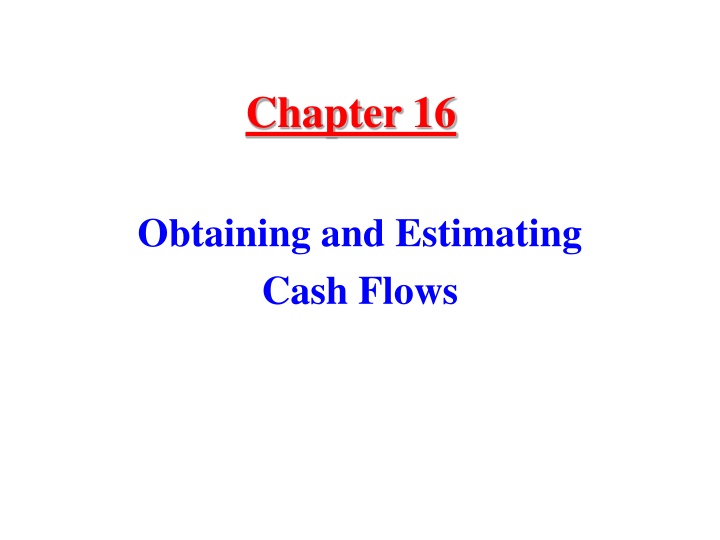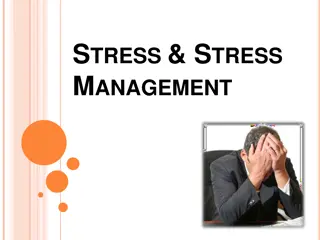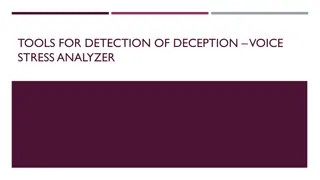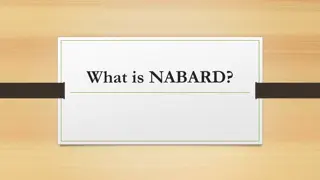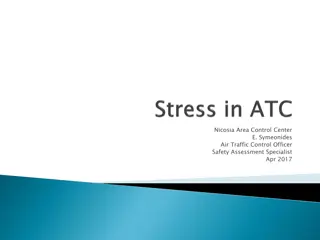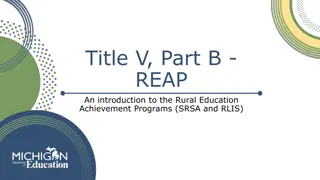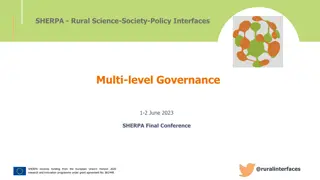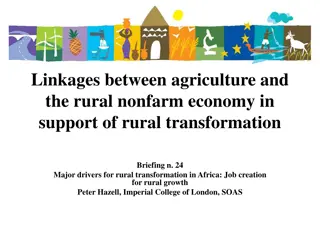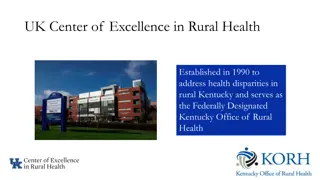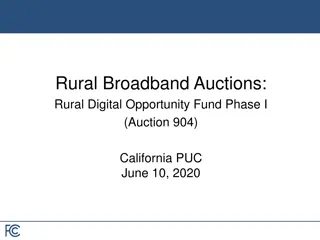Farm Stress and Rural Mental Health Programming
Informing to Transform: Research-based publications, trainings, and programs addressing rural mental health challenges and equipping professionals with knowledge to support farm communities. Topics cover understanding suicide, anxiety, depression, trauma response, and self-care strategies for stress management. Training sessions target healthcare providers, mental health professionals, ag-centric professionals, and community members to enhance their understanding of rural mental health issues. The program also offers podcasts and television segments to raise awareness about stress's impact on mental health in farming communities.
Download Presentation

Please find below an Image/Link to download the presentation.
The content on the website is provided AS IS for your information and personal use only. It may not be sold, licensed, or shared on other websites without obtaining consent from the author.If you encounter any issues during the download, it is possible that the publisher has removed the file from their server.
You are allowed to download the files provided on this website for personal or commercial use, subject to the condition that they are used lawfully. All files are the property of their respective owners.
The content on the website is provided AS IS for your information and personal use only. It may not be sold, licensed, or shared on other websites without obtaining consent from the author.
E N D
Presentation Transcript
Chapter 16 Obtaining and Estimating Cash Flows
Think of Chapter 16 as Two Separate but Related Topics 1. Cost terminology and estimation - for obtaining and understanding cash flows (16.1-16.3) Accounting principles to help understand economic analysis from the business perspective (16.4-16.5) 2. Only 16.2
Cost Terminology and Estimation (16.1-16.3) Introduction Why is this important? Five Cost Viewpoints Different perspectives yield different insights Cost Estimation Obtaining numeric values
Why Is This Important? (16-1) Economic decision making requires collecting data about the amount and timing of cash flows for the alternatives. A variety of sources is frequently required. Understanding viewpoints helps ensure that all relevant cash flows are collected. Understanding terminology for the various sources helps ensure that cash flows are properly interpreted. Read Example 16.1 for additional insight.
Cost Viewpoints (16-2) Five Cost Viewpoints Life Cycle Viewpoint Past/Future Viewpoint Manufacturing Cost Structure Viewpoint Fixed/Variable Viewpoint Average/Marginal Viewpoint
1. The Life Cycle Viewpoint The Life Cycle viewpoint focuses on when cash flows occur within the life cycle of an asset s (or project s) service life. First Cost Operating and Maintenance (O&M) Costs and Revenues Salvage Value
First Costs First Costs are the costs required to place the asset in service. Purchase Cost Training Cost Shipping and Installation Cost Initial Tooling Cost Supporting Equipment Cost Site Preparation
O&M Costs Operating and Maintenance (O&M) Costs are the routine costs required to keep the asset in service. A wide variety of costs may be considered here depending on the situation. Energy Costs Routine Maintenance (lubricants, filters, etc.) Indirect Labor etc. Maintenance costs may not be on a recurring, annual basis Preventive maintenance Maintenance on an as-needed basis Operating revenues estimated as recurring annual cash flow Consistent pattern: annual, gradient, and geometric Non-consistent pattern
Operating Revenues Operating Revenues are the revenues that result from having and using the asset. Revenues are typically estimated based on the volume and value of the parts that utilize the asset or result from the project. These revenues are ones that would not be available if the asset or project was not in service.
Salvage Value Salvage Value is the net cash flow resulting from disposing of the asset or terminating the project. Salvage Value may be positive or negative. Salvage Value is determined by deducting the cost of disposal from the market value of the asset at the time of disposal. Salvage value is typically one of the most difficult values to estimate. Scrap VS salvage values Market VS disposal VS salvage values Planning horizon Functional Economic
2. The Past/Future Viewpoint The Past/Future viewpoint focuses on when costs and revenues occur relative to time now . A past cost is any cost that occurred prior to time now . A future cost is any cost that is expected to occur subsequent to time now . Similar interpretations apply to past revenue and future revenue.
Sunk Cost is any past cost that cannot be reasonably expected to be recovered. Read Examples 16.2 and 16.3 for additional insight. Opportunity Cost is the cost of foregoing an opportunity to earn interest, or a return. Funds invested (or tied up in) one opportunity cannot be used for others. The difference in expected returns is an opportunity cost of the choice. The annual opportunity cost of holding $600 million dollars in inventory is $90 million/year if an interest rate of 15%/year is assumed. Example 16.4 provides an additional example.
Cost of Capital (CoC) refers to the cost of obtaining funds for investment. Cost of Capital provides a lower bound for MARR. MARR >= CoC Sources of capital are frequently used: Debtsources consist primarily of loans and bonds issuing bonds Equity sources consist primarily of stocks and accumulated prior earnings
3. Manufacturing Cost Structure Viewpoint The Manufacturing Cost Structurebreaks the selling price of a product into component pieces. Labels are applied to the component pieces and to various combinations of the component pieces. The labels can vary by company and by industry but the component pieces are usually consistent. A similar cost structure can be developed for non- manufacturing environments, however, some of the terminology for the component pieces and the combinations may differ.
Manufacturing Cost Structure Component Pieces Direct Materials Cost (DM) Direct Labor Cost (DL) Indirect Materials Cost (IM) hard to assign Indirect Labor Cost (IL) hard to assign Fixed and Miscellaneous Cost (F&M) General and Administrative Cost (G&A) Selling (Marketing) Cost (S) Profit (P) Read Example 16.5 for additional insight regarding the distinction between Direct and Indirect Costs
Manufacturing Cost Structure Combinations Selling Price = DM+DL+IM+IL+F&M+G&A+S+P = Cost of Goods Sold + Profit Conversion Cost = DL+IM+IL+F&M Prime Cost = DM+DL Factory Overhead = IM+IL+F&M Non Factory Overhead = G&A+S Cost of Goods: Manufactured = DM+DL+IM+IL+F&M = Prime Cost + Factory Overhead Sold = DM+DL+IM+IL+F&M+G&A+S = Cost of Goods Manufactured + Non Factory Overhead
4. Fixed and Variable Viewpoint A Fixed Cost (FC)is any cost that does not vary in proportion to the quantity of output. Examples include rent, depreciation, lighting, and supervisor salaries. Fixed Costs are commonly fixed only over a certain range of production, called the relevant range. For example supervisor salaries or lighting are fixed for one shift operation but step to a new higher level for two shift operation. Successive relevant ranges are often represented graphically as a step function.
Variable Cost (VC) is a cost that varies in proportion to the quantity of output. Common examples include direct materials and direct labor. Variable Costs are often represented as a linear function of output VC(x) = rate x ; where x is the level of production, rate is a unit cost Total Cost is the sum of fixed costs and variable costs TC(x) = FC + VC(x)
Breakeven Total Revenue (TR) is the sum of revenues received for the units sold. Total Revenue is often represented as a linear function of units sold. TR(x) = price x ; where x is the number of units sold, price is the selling price If steady state inventory is assumed then units sold will be equal to the units produced. The point of Breakeven, where total costs equal total revenues, can be found by solving: TR(x) = FC + VC(x)
Breakeven Graph Total Revenue Loss Profit Total Cost Breakeven Point Dollars Variable Cost Rate = Slope of Total Cost Line Fixed Cost Annual Production Volume (x in units)
If production (sales) is less than breakeven, a loss will occur. If production (sales) is greater than breakeven, a profit will occur. Lower values of the breakeven quantity are generally desirable. Lower values can be achieved by: increasing the revenue rate (the slope of the revenue line), decreasing the variable cost rate (the slope of the total cost line), reducing the fixed cost (the intercept of the total cost line). Engineering Economy projects frequently target one of these areas for improvement. Significance of Breakeven
Example 16.6 The cost of tooling and direct labor required to set up for a machining job on a turret lathe is $300. Once set up, the variable cost to produce one finished unit consists of $2.50 for material and $1.00 for labor to operate the lathe. For simplicity, it is assumed these are the only relevant fixed and variable costs. If each finished unit can be sold for $5, determine (1) the production quantity required to break even and (2) the net profit (or loss) if the lot size is 1,000 units. Determination of breakeven value R(x) = $5.00(x) FC = $300 VC(x) = ($2.50+$1.00)(x) = $3.50(x) Breakeven: R(x) = FC + VC(x) $5.00(x) = $300 + $3.50(x) x = 200 units
Net Profit for a lot size of 1,000 units Profit (or Loss) = TR(x) TC(x) = TR(x) (FC + VC(x)) = TR(x) FC VC(x) = $5.00(x) - $300 - $3.50(x) = $5.00(1,000) - $300 - $3.50(1,000) = $1,200 profit Another Breakeven Example is provided in Example 16.7
Generalizations of Breakeven The concept of breakeven is very general and can be applied to: Functions that do not represent revenue and/or cost, More than two functions, This may result in multiple breakeven values See Figure 16.4 for an example Non-linear functions. Example 16.9 includes a non-linear breakeven
5. Average and Marginal Viewpoint Average cost (AC) is the ratio of total cost to units of output. AC(x) = TC(x) / x = (FC + VC(x)) / x = FC / x + VC(x) / x If variable cost is linear with respect to x, then VC(x)/x is a constant (the variable cost rate), so, AC(x) = FC / x + VC rate
Economies of Scale Expressing average cost in this way, AC(x) = FC/x + VC rate leads to the idea of economies of scale. As production volume (x) increases, average cost decreases. This results from spreading the fixed cost (FC) over a larger and larger number of units. The fixed cost per unit (FC/x) is decreasing while the variable cost rate remains constant resulting in lower average cost per unit.
Marginal Cost (MC) is the incremental cost of additional production. In the discrete case, marginal cost is the cost of producing one more discrete unit. - the incremental cost increase of going from x units produced to (x+1) units produced. - it is usually determined through difference equations; TC(x+1) TC(x) Definitional Note: The marginal cost at x=5 is the additional cost incurred in producing the 6th unit, not the additional cost incurred in producing the 5th unit. Marginal cost can rightfully by defined either way, be careful of the definition in use. In the continuous case, marginal cost is the instantaneous rate of the change of the cost function. - It is determined by differentiating the cost function. - dTC(x)/dx evaluated at x Note: Same for marginal revenue
Example 16.8 Determine the marginal cost for the cost function: TC(x) = $60,000 + $30(x) at x=10 Discrete Approach MC(10) = TC(11) - TC(10) = ($60,000+$30(11)) ($60,000+$30(10)) = $60,330 $60,300 = $30 Continuous Approach MC(x) = d/dx[$60,000 + $30(x)] = $30 Similar results are obtained for x=20 It is worthwhile to note that since the variable costs are linear ($30*x), the marginal cost is a constant.
Cost Relationships: Marginal, Average, and Total Marginal Cost and Total Cost: If MC(x) > 0 then TC(x+1) > TC(x) If MC(x) = 0 then TC(x+1) = TC(x) If MC(x) < 0 then TC(x+1) < TC(x) Marginal Cost and Average Cost: If MC(x) < AC(x) then AC(x+1) < AC(x) If MC(x) = AC(x) then AC(x+1) = AC(x) If MC(x) > AC(x) then AC(x+1) > AC(x) Note: when x = , average cost = marginal cost
Example 16.9 (see page 784) Example 16.9 is an extended example that illustrates many of the concepts in this section for the non-linear case. In particular, it includes: Selling price that varies with demand, Linear cost but non-linear revenue and profit, Determination of marginal revenue and average profit functions, The distinction between maximizing revenue and maximizing profit, Multiple breakeven points.
Pit Stop #16 Is Accounting a Foreign Language? 1. When conducting an economic analysis, an engineer should consider costs from one and only one cost viewpoint. The cost of foregoing an opportunity to earn interest, or a return, on investment funds is referred to as a sunk cost. Prime cost is the sum of direct material cost and direct labor cost. If the cost function for producing x units is TC(x) = 700+0.6x and the revenue function is TR(x) = 2.0x; then the breakeven value is 500 units? The average cost function for Question 4 is given by AC(x) = 500 + 1.4x? False, the average cost function The tradeoff being considered when determining the level of detail of an estimate is the cost of making the estimate versus the cost of errors resulting from an inaccurate estimate. An income statement shows the assets, liabilities, and net worth of a firm at a point in time. False, an The fundamental equation of accounting states that assets = liabilities + net worth. EBIT can also be referred to as operating earnings. 10. In cost accounting, the acronym ABC refers to a Pareto analysis of costs where A items are most important, C items are least important, and B items are somewhere between. False, in cost accounting 11. EVA is a management tool that focuses manager s attention on adding value for the shareholders. 2. 3. 4. 5. 6. 7. 8. 9.
Pit Stop #16 Is Accounting a Foreign Language? 1. When conducting an economic analysis, an engineer should consider costs from one and only one cost viewpoint. False, all viewpoints should be considered. The cost of foregoing an opportunity to earn interest, or a return, on investment funds is referred to as a sunk cost. False, the cost of foregoing an opportunity is the opportunity cost. Prime cost is the sum of direct material cost and direct labor cost. True If the cost function for producing x units is TC(x) = 700+0.6x and the revenue function is TR(x) = 2.0x; then the breakeven value is 500 units? True The average cost function for Question 4 is given by AC(x) = 500 + 1.4x? False, the average cost function is AC(x)=700/x + 0.6 The tradeoff being considered when determining the level of detail of an estimate is the cost of making the estimate versus the cost of errors resulting from an inaccurate estimate. True An income statement shows the assets, liabilities, and net worth of a firm at a point in time. False, an income statement shows revenues, expenses, and resulting profit over a period of time. The fundamental equation of accounting states that assets = liabilities + net worth. True EBIT can also be referred to as operating earnings. True 10. In cost accounting, the acronym ABC refers to a Pareto analysis of costs where A items are most important, C items are least important, and B items are somewhere between. False, in cost accounting, ABC is the acronym for Activity Based Costing. 11. EVA is a management tool that focuses manager s attention on adding value for the shareholders. True 2. 3. 4. 5. 6. 7. 8. 9.
